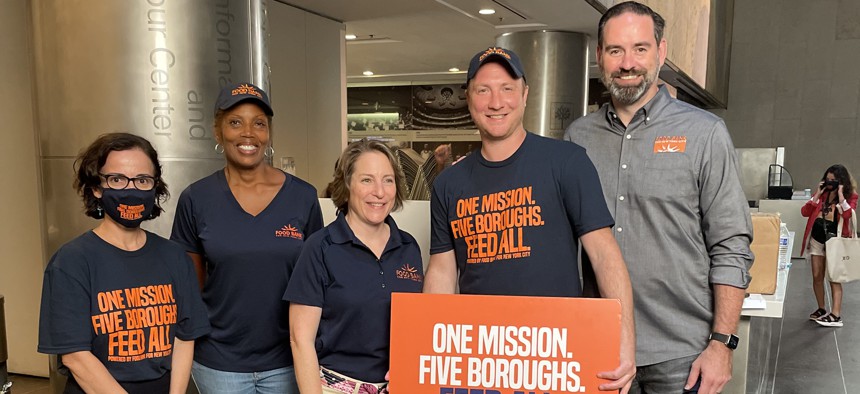sponsor content What's this?
Sponsored Content
How Grubhub and Independent Restaurants are Fighting Hunger, Approximately 500 Meals at a Time

When Deidre O’Neill gets a call from Brett Swanson of Grubhub, she knows it’s worth picking up — even if it’s in the middle of the lunch rush. Chances are, it will be good for business.
While the individual orders that come in via the delivery platform are a critical component of what many restaurant businesses rely on to make up their order volume, a call from Swanson can mean selling hundreds of meals in one fell swoop — just as it has for Deidre on several occasions. As the third-generation family member and proprietor of the 90-year-old O’Neill’s restaurant in Maspeth Queens, Deirdre has partnered with Grubhub multiple times to provide meals to the community, most recently at Borden Avenue Veterans Residence in Long Island City.
Swanson, recently named to City & State’s 2024 Who’s Who in Government Relations list, runs Grubhub’s community affairs program and is based in New York. That means he’s always on the lookout for beloved local eateries that can participate in the company’s efforts to combat hunger while supporting independent restaurants. Through its flagship Serving the City program, which launched in 2022, Swanson works with local leaders like City Council Members to provide culturally appropriate meals where they are needed most — such as senior centers, public housing facilities, veterans’ residences — by purchasing them directly from local community restaurants.
For restaurants like El Rincon de Mexico in the Allerton neighborhood of the Bronx, this meant Grubhub placed an order of 500 meals last June (including its signature beef birria dish) that was delivered to residents of Pelham Parkway Houses just two blocks east on Astor Avenue.
An order like that can mean the difference between finishing in the black for the month. And this cash flow can go toward operational improvements that are often hard for small, often minority-owned outposts to afford.
In 2023, the Serving the City program hosted 34 meal distributions in communities throughout all five boroughs, providing more than 30,000 meals — all cooked and purchased from local restaurants. This reflected an increase of more than 70 percent in meals delivered through Serving the City in its inaugural year, demonstrating the severe demand for such critical services among food-insecure populations. In fact, the program proved so effective that Grubhub has since expanded it to other major markets including Chicago, Boston, New Jersey and Philadelphia.
The approach is emblematic of the one that the delivery app platform has taken over the past several years in evolving its approach to community impact to better support neighbors and communities in the areas it operates and in a way the company is uniquely positioned to do.
The Grubhub Community Fund, first established in 2020, provides direct grants to organizations working to advance three main goals: 1) supporting independent restaurants, 2) helping close the hunger gap, and 3) creating more opportunities for people in the hospitality industry. In New York City, this has yielded more $5.8 million in grants to local nonprofits in the past four years, contributing to hundreds of thousands of additional meals served to those experiencing hunger and resulting in more than 560,000 pounds of food rescued in partnership with FoodRecovery.org and Rescuing Leftover Cuisine.
Just last month, a new effort launched to provide $200,000 in microgrants and business development opportunities to New York City restaurateurs in the Latino, Black, Indigenous, Asian American and Pacific Islander communities. Called the Rising Restaurateur program, the collaboration between the NYS Latino Restaurant and Bar Association, Oyate Group, and Grubhub is seeking applications from brick-and-mortar establishments, food trucks and carts, and other entrepreneurs in the food and beverage industry. Grants of up to $10,000 per establishment are available to help restaurateurs with fewer than 30 employees or less than $2 million in annual revenue. The application window is open through April 30, 2024.
These restaurants, like the majority of those that are served by Grubhub, are small and medium-sized, with limited ability to market themselves in ways that compete with the large budgets of major national chains. As Grubhub works with City Council to amend Covid-era restrictions that would give restaurants more options within the platform, it has also introduced new features such as the Grubhub for Restaurants portal and Grubhub Direct to give restaurant partners the tools and insights they need to grow and operate more efficiently.
While not every order that comes across the platform is going to be the kind that can make for a very strong week, these features and others are a small part of the way people like Swanson and his colleagues are seeking to empower local restaurants in new ways that ultimately help feed more New Yorkers.